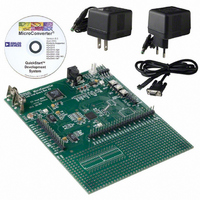EVAL-ADUC832QSZ Analog Devices Inc, EVAL-ADUC832QSZ Datasheet - Page 66

EVAL-ADUC832QSZ
Manufacturer Part Number
EVAL-ADUC832QSZ
Description
KIT DEV FOR ADUC832 QUICK START
Manufacturer
Analog Devices Inc
Series
QuickStart™ Kitr
Type
MCUr
Specifications of EVAL-ADUC832QSZ
Contents
Evaluation Board, Cable, Power Supply, Software and Documentation
Lead Free Status / RoHS Status
Lead free / RoHS Compliant
For Use With/related Products
ADuC832
Lead Free Status / RoHS Status
Compliant, Lead free / RoHS Compliant
Other names
EVAL-ADUC832QS
EVAL-ADUC832QS
EVAL-ADUC832QS
ADuC832
Embedded Serial Port Debugger
From a hardware perspective, entry into serial port debug mode
is identical to the serial download entry sequence described
above. In fact, both serial download and serial port debug modes
can be thought of as essentially one mode of operation used in
two different ways.
Note that the serial port debugger is fully contained on the
ADuC832 device, (unlike ROM monitor type debuggers) and
therefore no external memory is needed to enable in-system
debug sessions.
Single-Pin Emulation Mode
Also built into the ADuC832 is a dedicated controller for
single-pin in-circuit emulation (ICE) using standard production
ADuC832 devices. In this mode, emulation access is gained by
connection to a single pin, the EA pin. Normally, this pin is
hardwired either high or low to select execution from internal or
external program memory space, as described earlier. To enable
single-pin emulation mode, however, users will need to pull the
EA pin high through a 1 kΩ resistor as shown in Figure 64.
The emulator will then connect to the 2-pin header also shown
in Figure 64. To be compatible with the standard connector
that comes with the single-pin emulator available from Accutron
Limited (www.accutron.com), use a 2-pin 0.1 inch pitch “Friction
Lock” header from Molex (www.molex.com) such as their part
number 22-27-2021. Be sure to observe the polarity of this
header. As represented in Figure 64, when the Friction Lock tab
is at the right, the ground pin should be the lower of the two
pins (when viewed from the top).
Typical System Configuration
A typical ADuC832 configuration is shown in Figure 64. It
summarizes some of the hardware considerations discussed in
the previous paragraphs.
DEVELOPMENT TOOLS
There are two models of development tools available for the
ADuC832, namely:
These systems are described briefly below.
QuickStart Development System
The QuickStart Development System is an entry-level, low cost
development tool suite supporting the ADuC832. The system
consists of the following PC-based (Windows
hardware and software development tools.
Hardware:
Software:
Miscellaneous:
Windows is a registered trademark of Microsoft Corporation.
QuickStart—Entry-level development system
QuickStart Plus—Comprehensive development system
ADuC832 Evaluation Board and
Serial Port Programming Cable.
ASPIRE Integrated Development
Environment. Incorporates 8051
assembler and serial port debugger.
Serial Download Software.
CD-ROM Documentation and
Prototype Device.
®
compatible)
–66–
Figure 65 shows the typical components of a QuickStart Develop-
ment System. A brief description of some of the software tools
components in the QuickStart Development System follows.
Download—In-Circuit Serial Downloader
The Serial Downloader is a Windows application that allows the
user to serially download an assembled program (Intel Hex format
file) to the on-chip program FLASH memory via the serial
COM1 port on a standard PC. An Application Note (uC004)
detailing this serial download protocol is available from
www.analog.com/microconverter.
ASPIRE—IDE
The ASPIRE Integrated Development Environment is a Windows
application that allows the user to compile, edit, and debug code
in the same environment. The ASPIRE software allows users to
debug code execution on silicon using the MicroConverter UART
serial port. The debugger provides access to all on-chip peripherals
during a typical debug session as well as single-step, animate,
and break-point code execution control.
Note, the ASPIRE IDE is also included as part of the QuickStart
Plus System. As part of the QuickStart Plus System, the ASPIRE
IDE also supports mixed level and C source debug. This is not
available in the QuickStart System, but there is an example
project that demonstrates this capability.
Figure 65. Components of the QuickStart
Development System
Figure 66. Typical Debug Session
REV. 0




















